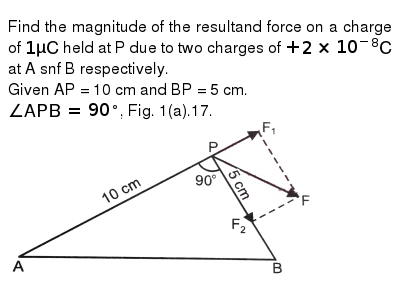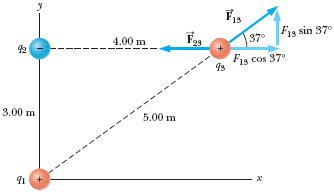How To Find Resultant Force On A Charge
You are then left with a single force vector from the -5q charge that is a distance707b away. If you all have any enquiries kindly leave a comment below and I will attend to it ASAP.

Find The Magnitude Of The Resultant Force On A Charge Of 1 Mc Held At P Due To Two Charges Of 2 X 10 8 C And 10 8 C At A And B
Forces P and Q act at an angle 0.

How to find resultant force on a charge. Then the force experienced by one charge due to the other charges is given by. Draw the force vector resulting from each charge. The resultant force can be determined also for three-dimensional force systems by using the polygon rule.
APB 90 from Physics Electric Charges and Fields Class 12 CBSE Electric Charges and Fields. The force vector from the q charge cancels that from the opposite corner. Find the magnitude of the resultant force on a charge of 1 C held at P due to two charges of 2 x 108 C and 108 C at A and B respectivelyGiven AP 10 cmand BP 5 cm.
In most cases reaction cancel out weight. For example if a box of 15 kg is subject to 5 forces which make it accelerate 20 ms 2 north-west then the resultant force is directed north-west and has the magnitude equal to 15 kg 20 ms 2 30 N. Three point charges q 4q and 2q are placed at the vertices of an equilateral triangle ABC of side l as shown in the figure.
The electric force like all forces is a vector. The closing side OB of the triangle taken in the reversed order represents the. The - and -components of the resultant force acting on charge are given by Thus from the Pythagorean theorem the magnitude of the resultant force is Furthermore the resultant force subtends an angle with the -axis and an angle with the -axis.
This means that the force exerted by charge 1 on charge 3 is directed along the -axis ie from charge 1 towards charge 3 and is of magnitude. B Find out the amount of the work done to separate the charges at infinite distance. Formula of Resultant Force If one force is acting perpendicular to another the resultant force is determined by using the Pythagorean theorem.
Considering the above example of 3 point charges Qa Qb and Qc with a position vector of r1 r2 and r3. Homework-and-exercises electrostatics charge vectors coulombs-law. Find the resultant electric force on a charge q.
Apply Coulombs law to determine the magnitude of the force. 75 mC 45 mC -90 mC 15 m 15 m. I know I need to split the force into its x and y components to find the resultant vector using RRx2 Ry2 but I do not know how to split these forces up.
Obtain the expression for the magnitude of the resultant electric force acting on the charge q. Since one charge is negative and the other is positive the charges will exert attractive forces on each other. In Figure OA and AB represent P and Q in magnitude and direction.
If surface is inclined then reaction and frictional force cancel out weight Atmospheric pressure applied uniform force in all directions on the body. The resultant force is the vector sum between the components. Since one charge is negative and the other is positive the charges will exert attractive forces on each other.
The Resultant force formula is given by FR. One can apply the head to tail method to construct the triangle. About Press Copyright Contact us Creators Advertise Developers Terms Privacy Policy Safety How YouTube works Test new features Press Copyright Contact us Creators.
Therefore the electric force on. The force acting between charges 1 and 3 is given by Since the force is repulsive. I then calculated that because the charges are equal each individual force enacted on charge Q is 63N.
First determine the direction of the force on q 1. Experiments show that when an object. A2 Level Charged ParticlesIts in the notes as an Example.
We could get the net force acting on a charge by calculating the vector sum of all the forces acting on the charge this is called the superposition theorem. 2 on q 3 3. In order to find the resultant of P and Q.
A resultant electric force on a charge Q b the potential energy of this system. Often however we know the forces that act on an object and we need to find the resultant force. Gravitation force results in its weight.
If there are several forces acting on the same point we can apply the polygon rule to find their resultant. Net Force F on middle due to L F on middle due to R Net Force 135 107 N - 162 107 N Net Force -027 107 N pointing left This is the method to solve any Force or E field problem with multiple charges. Click hereto get an answer to your question Four point charges Q q Q and q are placed at the corners of a square of side a as shown in the figureFind thea resultant electric force on a charge Q andb potential energy of this system.
Reaction force from the surface on which it lies.

Find The Magnitude Of The Resultant Force On A Charge Of 1 Muc Held At P Due To Two Charges Of 2xx10 8 C At A And B Respectively Given Ap 10
How To Calculate The Value Of Force Acting On One Charge Quora

Chapter 23 Electric Fields Ppt Video Online Download

Resultant Force And Coloumb S Law Of Electric Force Problems And Solutions Iit Jee And Neet Physics
Electric Force Article Electrostatics Khan Academy

Force Net On A Triangular Arrangement Of Charges Youtube

Resultant Force And Coloumb S Law Of Electric Force Problems And Solutions Iit Jee And Neet Physics

Resultant Force And Coloumb S Law Of Electric Force Problems And Solutions Iit Jee And Neet Physics

Find The Magnitude Of The Resultant Force On A Charge Of 1 Muc Held At P Due To Two Charges Of 2xx10 8 C At A And B Respectively Given Ap 10

Find The Magnitude Of The Resultant Force On A Charge Of 1 Mc Held At P Due To Two Charges Of 2 X 10 8 C And 10 8 C At A And B
Example 3 2 Electrostatic Force Between Three Non Colinear Point Charges

Finding Resultant Force On A Charged Particle In An Electric Field Example Youtube
Three Point Charges Spinning Numbers

Charges Of 5 Muc 10 Mu C And 10 Mu C Are Placed In Air At The Corners A B And C Of An Equilateral Triangle Abc Having Each Side Equal
Three Charges Each Of The Q Coulomb Are Kept At The Vertices Of An Equilateral Triangle Of Side Metre What Is The Resultant Force Acting On Any One Of The Charges And

The Force Exerted By Q1 On Q3 Is Vector F 13 The Chegg Com

Determine The Magnitude Of The Resultant Force At A Youtube

Resultant Force And Coloumb S Law Of Electric Force Problems And Solutions Iit Jee And Neet Physics

Resultant Force And Coloumb S Law Of Electric Force Problems And Solutions Iit Jee And Neet Physics

Post a Comment for "How To Find Resultant Force On A Charge"